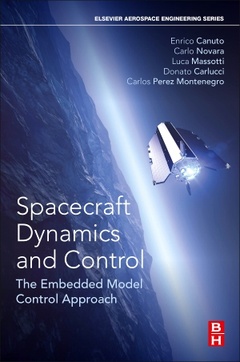Description
Spacecraft Dynamics and Control
The Embedded Model Control Approach
Aerospace Engineering Series
Authors: Canuto Enrico, Novara Carlo, Carlucci Donato, Montenegro Carlos Perez, Massotti Luca
Language: English
Subjects for Spacecraft Dynamics and Control:
153.10 €
In Print (Delivery period: 14 days).
Add to cart790 p. · 19x23.3 cm · Paperback
Description
/li>Contents
/li>Readership
/li>Biography
/li>Comment
/li>
Spacecraft Dynamics and Control: The Embedded Model Control Approach provides a uniform and systematic way of approaching space engineering control problems from the standpoint of model-based control, using state-space equations as the key paradigm for simulation, design and implementation.
The book introduces the Embedded Model Control methodology for the design and implementation of attitude and orbit control systems. The logic architecture is organized around the embedded model of the spacecraft and its surrounding environment. The model is compelled to include disturbance dynamics as a repository of the uncertainty that the control law must reject to meet attitude and orbit requirements within the uncertainty class. The source of the real-time uncertainty estimation/prediction is the model error signal, as it encodes the residual discrepancies between spacecraft measurements and model output. The embedded model and the uncertainty estimation feedback (noise estimator in the book) constitute the state predictor feeding the control law. Asymptotic pole placement (exploiting the asymptotes of closed-loop transfer functions) is the way to design and tune feedback loops around the embedded model (state predictor, control law, reference generator). The design versus the uncertainty class is driven by analytic stability and performance inequalities. The method is applied to several attitude and orbit control problems.
2. Attitude Representation
3. Orbital Dynamics
4. The Environment: Perturbing Forces and Torques
5. Perturbed Orbital Dynamics
6. Attitude Kinematics: Modeling and Feedback
7. Attitude Dynamics: Modeling and Control
8. Orbit and Attitude Sensors
9. Orbit and Attitude Actuators
10. Attitude Determination
11. Orbital Control and Prediction Problems
12. Attitude Control: A Case Study
13. Introduction to Dynamic Systems
14. Introduction to Embedded Model Control
Index
Researchers and practitioners in the field of control engineering, aerospace engineering, mechanical engineering, and applied mathematics.
Carlo Novara is an Associate Professor at Politecnico di Torino. He was a visiting researcher at the University of California at Berkeley in 2001 and 2004. He is the author or co-author of about 100 scientific publications in international journals and conference proceedings. He has been involved in several national and international projects and in several research contracts in collaboration with Italian and European companies. He has worked for more than 15 years in the fields of nonlinear system identification and control and, recently, he is bringing his experience in these fields to the aerospace sector. His current research interests include satellite attitude, drag free and formation control. He is teaching a course on Aerospace modelling and control at Politecnico di Torino.
Donato Carlucci is an Associate Professor at Politecnico di Torino. He is the author or co-author of scientific publications on applied nonlinear systems control. He has been involved in national and international projects in collaboration with Italian and European industries. He has worked for more than 40 years in the fields of nonlinear system control including aerospace systems. His current research interests include satellite attitude control. He is teaching courses on Automation and Production Systems at Politecnico di Torino
Carlos Norberto Perez M
- The book begins with an extensive introduction to attitude geometry and algebra and ends with the core themes: state-space dynamics and Embedded Model Control
- Fundamentals of orbit, attitude and environment dynamics are treated giving emphasis to state-space formulation, disturbance dynamics, state feedback and prediction, closed-loop stability
- Sensors and actuators are treated giving emphasis to their dynamics and modelling of measurement errors. Numerical tables are included and their data employed for numerical simulations
- Orbit and attitude control problems of the European GOCE mission are the inspiration of numerical exercises and simulations
- The suite of the attitude control modes of a GOCE-like mission is designed and simulated around the so-called mission state predictor
- Solved and unsolved exercises are included within the text - and not separated at the end of chapters - for better understanding, training and application
- Simulated results and their graphical plots are developed through MATLAB/Simulink code




